Ed Scarpo's Blog, page 25
December 28, 2015
Gambino Boss Paul Castellano Reconsidered

I used to be a rapacious re-reader back when I was younger and had a sizable amount of spare time.
Books I particularly loved I'd read repeatedly. S.E. Hinton's The Outsiders (published in 1967, it is currently a number 1 bestseller on Amazon) probably was the first book I devoured a multitude of times, liberally underlining and highlighting as I flipped through the pages. For the purposes of this story, I'll note that I also read certain mob books -- all of Jerry Capeci's -- so many times that they literally fell apart in my hands, prompting me to repurchase them. (Of course, this was before ebooks existed.)
While I didn't memorize these books, each made certain impressions on me. Interesting details stayed with me over the years. Now, years later, I still recall some details, though it usually takes time for me to locate the corresponding book. Which brings me to this story...
A recent mention of a certain "explosive revelation" about Paul Castellano resulted from a detail from Mobstar
 . Capeci literally just tosses it out. The same detail was mentioned within Sammy the Bull'
. Capeci literally just tosses it out. The same detail was mentioned within Sammy the Bull' s testimony.
s testimony.To truly gain an understanding of Paul Castellano, as well as why John Gotti had to take over the family, you need to be aware of this information, then go back and reconsider everything you know about the story of Paul Castellano
 's execution.
's execution.This story posits that it was Castellano's own fault he was killed. He'd played a deadly game and lost. He was "testing" his cohorts in crime. Think of Sammy the Bull's anecdote regarding how Big Paul gauged his reaction to Roy DeMeo's death. Castellano always tested his men. For that, they killed him.
And while Castellano may have presented himself as a Fortune 500 CEO, while he may have subscribed to the Wall Street Journal, he was a far more violent mob boss than is believed. Both his hands were drenched in blood.
Among his key fatal flaws were his relentless greed and his faith in the Mafia's historical hierarchical system.
Other revelations to be examined: John Alite says that John "Junior" Gotti told him that Castellano would be executed before the hit took place.
Also, a member of the Gotti family has told me that John Gotti was not in the car on that December night in 1985. Sammy the Bull's scenario that he and Gotti sat in a car watching the hitters gun down the Gambino's two top-ranking members was a fable concocted by Sammy to make his testimony as relevant as possible, the source opined.
This story is still in a draft phase but will be posted soon.....




Published on December 28, 2015 21:49
New England Mafia "Sleeps with the Fishes?"
 Reputed New England boss "Spucky" Spagnolo is 72.
Reputed New England boss "Spucky" Spagnolo is 72.Two New England Mafiosi in their 70s, including the alleged acting Patriarca Family boss, are going to prison after copping to a years-long extortion scheme in federal court.
On December 16, Antonio “Spucky” Spagnolo, 73, and Pryce “Stretch” Quintina, 75, pleaded guilty to charges of conspiracy to affect commerce by extortion, MassLive.com reported.
Prosecutors alleged that Spagnolo, of Revere is the acting boss of the New England Mafia. Co-defendant, Quintina, 75, also of Revere, reported to Spagnolo, prosecutors said.
Both men pleaded guilty in U.S. District Court in Boston to charges of conspiracy to affect commerce by extortion for threatening the owner of the Revere Moose Lodge and another businessman, the Boston Globe reported,
If Judge Patti B. Saris approves a plea agreement between prosecutors and the two mobsters, Spagnolo will be sentenced to two years in prison and Quintana to 18 months.
A sentencing hearing is slated for March 24.
The charges center on the extortion of thousands of dollars in protection money from Boston-area Constitution Vending, a slot-machine manufacturer, and the Revere Moose Lodge social club.
Spagnolo allegedly took control of the New England mafia two years ago when Anthony DiNunzio was sent to prison. DiNunzio is the brother of convicted New England Mafia underboss Carmen “The Cheeseman’’ DiNunzio, who was released from prison earlier this year.
Constitution Vending Racket
Constitution Vending Co. had been setting up illegal poker machines in local bars and restaurants and splitting the profits with the bar owners for more than a decade. During the time that racket was in place, the company had paid Quintana and Spagnolo protection payments, or "rent payments," according to prosecutors.
When the Revere Moose Lodge turned to another company to install some machines, Spagnolo and Quintana intervened and allegedly threatened those involved, thereby earning their pay.
Basically, for their help in fending off any competition, the two mobsters pocketed more than $50,000 from 2004 to 2012.
Assistant US Attorney Timothy Moran said that the two men made “implied” threats.
Former boss Anthony L. DiNunzio was sentenced in 2012 to 78 months in federal prison for racketeering. He is the brother of Carmen “The Big Cheese” DiNunzio, who served a state sentence for bribery.
Spagnolo served a nine-year prison sentence in the 1990s for racketeering and drug dealing. Quintana served more than seven years for racketeering.
The two men were not required to acknowledge their reputed Mafia membership.
Both Quintana and Spagnolo were supposedly in attendance at the infamous October 1989 Mafia induction meeting in Medford that was secretly recorded by the FBI.
A Notorious Induction CeremonyOn Oct. 29, 1989, New England Mafia boss Raymond “Junior” Patriarca anointed four new soldiers into his crime family. A full-blown ceremony with a total of 21 wiseguys in attendance, it occurred following a civil war.
Junior's father, Raymond L.S. Patriarca, was the founder of the crime family, also called the New England crime family, the Providence crime family and the Boston crime family.
After the 1984 death of Patriarca Senior, the New England Mafia declined and the family's two historic factions -- one based in Providence, Rhode Island, the other in Boston -- vied for control.
 Legendary Boston Cosa Nostra boss Jerry AngiuloJerry Angiulo, the family underboss, moved to take control of the entire organization.
Legendary Boston Cosa Nostra boss Jerry AngiuloJerry Angiulo, the family underboss, moved to take control of the entire organization.Larry Zannino, a top lieutenant, supported Patriarca Junior, however. New York's Gambino crime family also bolstered Junior's ascendancy, demoting Angiulo and naming Zannino consigliere.
Junior was not his father -- and was viewed as too weak for the top spot. But with the continuing support of the Gambino family, he prevailed. For a time.
In 1987, Zannino was zinged with a 30-year prison stretch. His absence only underlined Junior's weakness.
William "Wild Guy" Grasso was named underboss next. A cunning, ruthless mobster, many thought he was the real power in the family. In June 1989 a mob hitter tied to the Genovese family took Grasso out, it's alleged.
Nicholas Bianco then took over the family's Providence operations.
It was against this backdrop that the 1989 ceremony played out, and is also the reason why Junior Patriarca seemed to hedge his words.
“We’re all here to bring in some new members into our family and more than that, to start maybe a new beginning,” Patriarca told attendees. “Put all that’s got started behind us ... and bygones are bygones and a good future for all of us.”
The entire proceeding was captured by a bug planted inside 34 Guild Street, the address of the house, which Vincent Federico, one of the four initiates, had "borrowed" from his sister for the day.
The FBI matched Junior's voice to the tape using a radio interview the young mob boss had participated in.
Many of the mobsters present that day were indicted on federal racketeering charges, leading the Globe to report: "The New England Mafia's hierarchy, what was left of it, went to prison, leaving the family in disarray."
"Baby Shacks"
Luigi “Baby Shacks” Manocchio, who ran the Patriarca crime family out of Addie’s Laundromat on Federal Hill, was convicted in 2012 for his role in extorting monthly payments from Providence strip clubs, totaling $800,000 to $1.5 million and dating to the 1990s. He reportedly relinquished his position in 2009, resulting in a power shift to Boston.
The New England Mafia has been declining for decades, its ranks dwindling following a series of federal prosecutions dating back in the 1980s. Seven bosses and underbosses and scores of underlings were sent to prison.
The New England Mafia historically made its money through illegal gambling, loansharking, and extortion, and in more recent years expanded into drug trafficking, according to authorities. Law enforcement officials predict that the opening of casinos in Massachusetts will probably end a vital revenue stream for the New England mob.
Former New England mob underboss Carmen “The Cheese Man” DiNunzio, 57, was released in February after serving six years in prison for bribery, extortion, and illegal gambling, and quietly returned to his home in East Boston.
DiNunzio’s younger brother, Anthony, 56, briefly served as acting boss before he was convicted in 2012 of racketeering and sentenced to 6½ years in prison. He is slated to be released in 2018.The leadership of the New England Mafia historically had shifted between Providence and Boston for 50 years. The paradigm was the boss would be in one city and the underboss in the other. But since Manocchio stepped down, the top two positions have remained in Boston.
 Peter Limone, official boss of the New England Mafia (or what's left of it)....
Peter Limone, official boss of the New England Mafia (or what's left of it)....Peter "The Crazy Horse" Limone reportedly succeeded "Baby Shacks" as the official boss of the Patriarca crime family.
Limone, 80, was wrongly convicted and imprisoned for a 1965 murder based Joe “The Animal” Barboza's false testimony. Limone served 33 years in prison before his 2001 release. He and his co-defendants were reportedly awarded $102 million for their wrongful imprisonment. Limone made around $25 million from the agreement -- but was still caught for loansharking and other rackets in 2010. He received five years probation.




Published on December 28, 2015 10:57
December 27, 2015
Linda Scarpa's Mafia Daughter Memoir Debuts
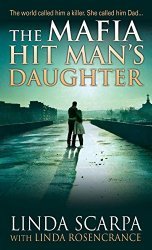 Linda Scarpa's memoir about life with the mob hitter
Linda Scarpa's memoir about life with the mob hitterknown as the Grim Reaper aka Greg Scarpa.
Click on the cover to purchase....

By Nick Christophers, guest contributor, editor of Mob Candy (see his website):
We have been inundated with books, films and TV shows on the subject of the Mafia over the years. Wives, girlfriends and daughters have taken to the pen to expose their experiences. Yet many of them have either “sugar-coated” their stories or they really had no knowledge of “the life.”
One of the earliest books that delved deep into the life was “Mafia Marriage
 ” by Rosalie Bonanno, who was married to Salvatore Vincent “Bill” Bonanno
” by Rosalie Bonanno, who was married to Salvatore Vincent “Bill” Bonanno , the son of Cosa Nostra boss Joseph Bonanno
, the son of Cosa Nostra boss Joseph Bonanno .
. Since then there have been many attempts to expose the true meaning of living in that world, e.g., “This Family of Mine
 ” by Victoria Gotti, daughter of John Gotti, former boss of the Gambino crime family; “The Godfather’s Daughter
” by Victoria Gotti, daughter of John Gotti, former boss of the Gambino crime family; “The Godfather’s Daughter ” by Rita Gigante, daughter of Vincent Louis Gigante, also known as “Chin,” one-time boss of the Genovese crime family; and “Mob Daughter
” by Rita Gigante, daughter of Vincent Louis Gigante, also known as “Chin,” one-time boss of the Genovese crime family; and “Mob Daughter ” by Karen Gravano, daughter of Salvatore “Sammy the Bull” Gravano, a former underboss of the Gambino crime family.
” by Karen Gravano, daughter of Salvatore “Sammy the Bull” Gravano, a former underboss of the Gambino crime family. But few books have truly captured mob life the way Linda Scarpa has in her new book “The Mafia Hit Man's Daughter.”
The book is a page turner, offering names, dates and facts that are truly eye openers. Linda makes no effort to hide anything or to deviate from the truth. “The Mafia Hit Man’s Daughter” is laced with the love and passion her father, Colombo family hit man Greg Scarpa, had for her and she for him – as well as his passion for revenge. However, never does Linda attempt to paint her father – or anyone else in the life – as an angel.
This is evident when she describes the terror of being caught in the crossfire when a hit team is sent by her father’s enemies – members of a rival faction of the Colombo crime family – to murder him.
One day Linda was leaving the family’s house in Brooklyn with her infant son at the same time her father and a couple of guys in his crew were heading out. As she was pulling out of the driveway, a van came barreling up the street. Linda cut the van off. Before she knew what was happening, her father was ambushed by his enemies. She and her son were in the middle of the shooting.

Linda makes no effort to hide anything or to deviate from the truth...
Paralyzed with fear, she watched as these assassins riddled her father’s car with bullets – some even hit her car. Somehow Greg survived but the love he had for his daughter and grandson, who both could have been killed, drove him to seek revenge on the men responsible. It was then that Linda realized her father wasn’t invincible and neither was his family.
“The Mafia Hit Man's Daughter” is not for the faint of heart as Linda recounts in often gruesome detail all the trials and tribulations she and her family suffered because her father was a big-time mobster. Greg Scarpa was a rare individual in the underworld; he played by his rules and only his rules. His main goal was to protect his family, not the Family. Greg was a true gangster but in his heart and mind, his blood family came first.
“This is a heartbreaking life, one day filled with an abundance of family and friends and love and the next day filled with heartache, loss and loneliness,” Linda said in an interview. “But the one thing that always stayed true is the unconditional love between a father and daughter. In my case I felt that no matter what, the true story needed to be told from inside our home. I tell my story from first-hand experiences, as only I can tell it because I was around my father through the best of times and the worst.”
The beauty of “The Mafia Hit Man’s Daughter” is that Linda does not paint a pretty picture of the life but rather offers shocking revelations about what goes on inside a Mafia family.
Linda tells of living with a man who truly did love his children and their mother but was swallowed up by the life in the end. People think they know who Linda’s father was – but they don’t. All they know is what they read in the tabloids or in books written by outsiders.
“The Mafia Hit Man's Daughter” is Linda Scarpa’s no-holds-barred story of what really went on behind closed doors, not some romanticized, glamorized version of her father’s involvement in the Mafia. It is a must-read for anyone interested in learning the truth about what it was like living with a loving, caring father, who was also an infamous Mafia hit man.
To learn more go to The Mafia Hit Man's Daughter




Published on December 27, 2015 16:12
Anastasia's Home with "Strange Room" for Sale
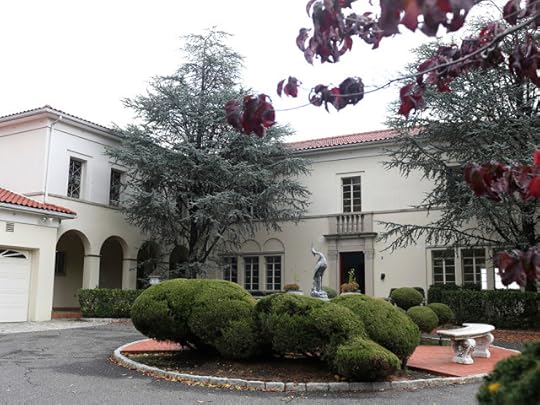 Anastasia's home in Fort Lee will be auctioned off. It includes a "strange tiled room."
Anastasia's home in Fort Lee will be auctioned off. It includes a "strange tiled room."In North Jersey's Fort Lee sits a mansion for sale that was once owned by one of the most powerful and feared Cosa Nostra bosses in the American Mafia's history: Albert Anastasia.
Described as a sprawling Mission-style estate, it's located at 75 Bluff Road and, according to a recent published report, it hasn't changed much since Anastasia had it built in 1947. The house was bigger than others in the area back then. In fact, the 25-room luxurious spread ruined the scenic view of Manhattan for at least one family, though they aren't known to have complained.
North Jersey has been described as a gangsters paradise. The list of previous North Jersey residents includes the enigmatic Joe Adonis
 , Willie Moretti
, Willie Moretti  and Longie Zwillman
and Longie Zwillman , though the last owner was the "most famous and feared of all, the head of Murder Incorporated, Albert Anastasia," as the New York Times noted. New Jersey itself was and is a key area of activity for many crime families; in fact, as noted, at least seven were known to have operated there.
, though the last owner was the "most famous and feared of all, the head of Murder Incorporated, Albert Anastasia," as the New York Times noted. New Jersey itself was and is a key area of activity for many crime families; in fact, as noted, at least seven were known to have operated there.The former Albert Anastasia
 estate was to set for a Dec. 8 auction, which was reportedly postponed due to an ongoing renovation project. The wealthy Mafia aficionado might be able to pick it up for a song considering the $5 million minimum. (The seven-bedroom, 13,500-square-foot estate next door, built in 2007, sold this past June for $18.9 million). Trucking and ferry mogul Arthur Imperatore Sr., is the current owner looking to sell the mansion.
estate was to set for a Dec. 8 auction, which was reportedly postponed due to an ongoing renovation project. The wealthy Mafia aficionado might be able to pick it up for a song considering the $5 million minimum. (The seven-bedroom, 13,500-square-foot estate next door, built in 2007, sold this past June for $18.9 million). Trucking and ferry mogul Arthur Imperatore Sr., is the current owner looking to sell the mansion. Anastasia's view of Manhattan.
Anastasia's view of Manhattan.After his infamous 1957 barbershop execution, Anastasia's family departed the estate.
Del Webb
 , the powerful Southwestern developer and former Yankees
, the powerful Southwestern developer and former Yankees  owner, helped buy the 25-room property for friend Buddy Hackett
owner, helped buy the 25-room property for friend Buddy Hackett .
.Imperatore, 90, decided to sell after his wife's death this year. "Part of the reason for the home’s relatively modest price could be that the Anastasia estate is remarkably intact, perhaps too much so," the Times reported.
 Slot machine located in the basement, along with other things.....
Slot machine located in the basement, along with other things.....The Hacketts and the Imperatores did not change much, and in recent years, paint has begun to peel and plaster crumble. Still, the tiled roof, marble fireplace and rolling grounds are well preserved. Plush carpeting and single-pane windows will probably go, but the views stretching from the George Washington Bridge to the World Trade Center cannot be replaced. Vintage kitchens and bathrooms have almost as much tile as Pompeii.
“Given his connections, I could see Anastasia going down to the tile union, and before you know it, a dozen of their best guys were up here,” Arlan Ettinger, the president of Guernsey’s and Imperatore friend, said during the Times's tour last week.
The report noted that, despite its breathtaking facade, the home includes "some details [that] betray its violent foundations."
The stucco exterior walls are at least a foot thick, and every room has two or more doorways, for quick getaways. Sandy Hackett, the comedian’s son, recalled a false wall in his sister’s closet that led to a guest bedroom (the passage itself appears to have vanished today), and there were rumors of a tunnel into the cliffside. The basement could rival most homes in size and opulence, with a dozen rooms, including one that the elder Mr. Hackett converted into a screening room, complete with a bar and fake candy stand...
And then there was the strange tiled room with a drain in the floor and nothing else. The younger Mr. Hackett said his father turned it into a dark room for developing film, but when he asked about it as a child, he was told it was originally used to carve up deer after hunting trips.
“Whenever you went in there, it was always five degrees colder, just chilly and eerie,” Mr. Hackett said in a phone interview from Los Angeles. “I don’t know about deer, but they were definitely slaughtering something in there.” The Imperatores replaced it with a sauna and Jacuzzi room.
 Joe Adonis
Joe AdonisAdonis
 was probably Anastasia's closest neighbor. He eventually settled in Fort Lee too, on Dearborn Road, about a quarter-mile from Anastasia's house.
was probably Anastasia's closest neighbor. He eventually settled in Fort Lee too, on Dearborn Road, about a quarter-mile from Anastasia's house.Born in Italy's Montemarano, which is near Naples and within the province of Avellino, he arrived in the U.S. with his family as a child. A longtime Brooklyn mobster, he was affiliated with such Mafia luminaries as Frankie Yale
 and Anthony Carfano -- aka "Little Augie" Pisano
and Anthony Carfano -- aka "Little Augie" Pisano . In fact, following Yale's murder, Adonis --along with Pisano, Vito Genovese and Mike Miranda -- were among the most prominent Neapolitans working within Giuseppe Masseria's organization in 1920s New York.
. In fact, following Yale's murder, Adonis --along with Pisano, Vito Genovese and Mike Miranda -- were among the most prominent Neapolitans working within Giuseppe Masseria's organization in 1920s New York.Adonis was known to have directed activity on the Brooklyn docks alongside Anastasia. He also ran a Brooklyn eatery, Joe's Italian Kitchen on Carroll Street and Fourth Avenue.
He was among a select group targeted for elimination by Maranzano following the Castellammarese War in 1931, when New York's "official" Five Families were established. Maranzano was assassinated before he could strike first.
Known to be a major player in the reorganized underworld, amazingly few basic details are even known about Adonis.Also unknown is precisely which crime family he belonged to and what rank he'd held -- though sources narrow his affiliation down to either the Brooklyn-based Mangano crime family or Luciano's Manhattan-based borgata. Whatever crime family he was formally tied to, Adonis, it's generally agreed, owed his primary allegiance to Luciano and Frank Costello
 , both longtime personal friends.
, both longtime personal friends.Adonis went on to run a range of rackets that included booze, gambling, drugs and labor racketeering. He, Costello and Jewish mobsters Meyer Lansky and Benjamin Siegel together owned the Colonial Inn casino in Miami Beach. Adonis also shared a gambling empire in New Jersey with Mafioso Willie Moretti.
Threatened by legal troubles in 1953 that grew progressively worse, three years later, he voluntarily deported himself to Italy. (See famous headline about this here.) Otherwise, he'd have faced a perjury charge that had arisen from the Kefauver Committee hearings. (How bad would a perjury pinch have been?) The Italian government wasn't crazy about getting him, either. So he found himself in an exile-within-an-exile position. On June 20, 1971, a Milan court ordered him to stay within the confines of the town of Ancona, where Adonis died months later, on Nov. 26, 1971.
His remains were returned to the United States and buried in Fort Lee's Madonna Roman Catholic Cemetery.
"Longie" Zwillman
Abner "Longie" Zwillman
 was among North Jersey's most powerful and influential figures during the Prohibition Era and beyond. Known as the "Al Capone" of his state, he also was known as a political powerhouse. Zwillman amassed a fortune through rum-running, gambling and coin-operated machines.
was among North Jersey's most powerful and influential figures during the Prohibition Era and beyond. Known as the "Al Capone" of his state, he also was known as a political powerhouse. Zwillman amassed a fortune through rum-running, gambling and coin-operated machines.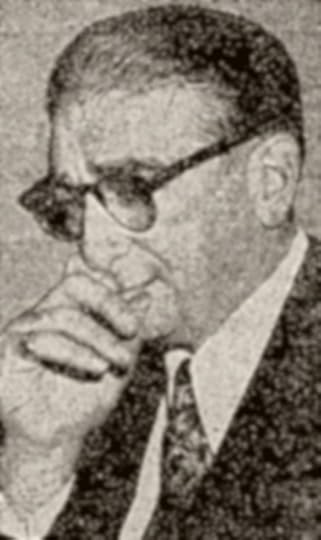 Zwillman
ZwillmanOn Feb. 26, 1959, Zwillman was found dead in his West Orange home. That morning, his wife discovered his lifeless body suspended from its neck by a loop of electrical cord tied to a basement rafter. She told police she recalled her husband getting up in the middle of the night complaining of chest pains.
The Essex County Medical Examiner Dr. Edwin Albano almost immediately ruled the death a suicide by hanging. Zwillman's stepson revealed that the racketeer had been depressed for some time and worried about the jury bribery cases. Zwillman had reportedly battled deep depression since Senate investigators recently began examining his role in the jukebox industry.
An estimated 150 mourners paid their respects on the evening of Feb. 26, and Zwillman's funeral was held the next day. Reporters identified Manhattan restaurateur Toots Schor and movie producer Dory Schary at the funeral.




Published on December 27, 2015 15:25
December 22, 2015
Mobster Left His Life in San Francisco
 Why did the Lanza family execute DeJohn?
Why did the Lanza family execute DeJohn?The American Mafia lost a few members in 1947, some well known, some not so well known.
Among that year's deceased were Jacob "Gurrah" Shapiro, a New York-based labor racketeer who worked with Louis "Lepke
 " Buchalter (executed in 1944); Al Capone
" Buchalter (executed in 1944); Al Capone and Benjamin "Bugsy
and Benjamin "Bugsy " Siegel. (On the other side of the legal fence, Fiorello La Guardia, the Mayor of New York who very publicly targeted New York's Mafia, died in 1947.)
" Siegel. (On the other side of the legal fence, Fiorello La Guardia, the Mayor of New York who very publicly targeted New York's Mafia, died in 1947.)Nicholas DeJohn died that year. Ever hear of him? He was a mobster who came up in the Outfit then hauled ass for San Francisco, where he found a role in the local organized crime landscape. He died brutally in 1947; he was strangled to death, in fact. His body fermented in a trunk of a car for two days before it was discovered. The murder was never solved -- but a piece of evidence showed up in a certain pawn shop that puts an interesting twist on DeJohn's story....A hint -- Gurrah, Lepke and Bugsy had all been a part of it.
Just another mobster killed for making the wrong enemy. Or being in the wrong place at the wrong time. Take your pick. We do know at one point he was on the wrong side, which is why he departed the Outfit for San Francisco.
In Chicago in the late 1930s, DeJohn was a rising star in the Outfit under Frank Nitti's control. “In Chicago he was reputed to be a bookie" and was alleged "to have 10 or 12 bookies under his jurisdiction," noted an excerpt from Lanza’s Mob: The Mafia and San Francisco 1928-2006 authored by Christina Ann-Marie DiEdoardo (PDF link. The book apparently wasn't published yet.)
Frank "The Enforcer" Nitti, was among Capone's top henchmen. At the helm of the Outfit's "muscle," Nittit succeeded Capone as Chicago Outfit boss.
DeJohn's trajectory fell apart once he backed the losing side in an effort to take control of a gambling wire service, the Continental, according to the Examiner, which added that by 1946, after five partners joined the ranks of the nonliving, the mobster decided a change in scenery was necessary.
De John lived in Alameda County before buying a house in Santa Rosa.
Whatever this big-city mobster tried to do in the Bay area city, he pissed off the wrong guy.
Frank Lanza, LCN Family Founder
Francesco "Frank" Lanza's family controlled loansharking, gambling, prostitution, narcotics and bootlegging. The Lanza family was the smallest of all America's Mafia families, with 20 to 25 members.Lanza operated the San Francisco Fisherman's wharf with his business partner, Giuseppe Alioto, who also founded the International Fish Company.
In 1937 Lanza died of natural causes at the age of 54. His son, James Lanza, would later take over as boss of the family. During the 1940s and 1950s, Lanza was Michael Abati's underboss. In 1957, he attended the infamous Apalachin Summit with other West Coast mobsters, including Frank DeSimone, Simone Scozzari and Joseph Cerrito.
Jimmy “The Hat” Lanza, ran the family from 1961 to 1989, and died in 2006, at the ripe old age of 103.
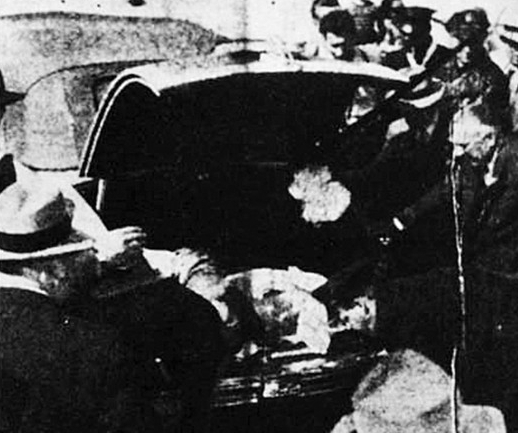
His body was arranged in a tableau that cannot be described in a family newspaper — the mob was sending a strong message of disapproval. ... but for what?Who Is DeJohn?
DeJohn (who also was known as Nick Rossi) invested in the Sunland Oil Company, becoming partners with the founder's successor, Lima, his underboss Michael Abati, and others.
No one was ever convicted for his murder. And "after the DeJohn killing, the Mafia in the City by the Bay continued its operations more or less unmolested by law enforcement for years," according to an excerpt from an as-yet unpublished book.
Interestingly the powerful Cosa Nostra families in New York and Chicago had eyed the West Coast and managed to infiltrate Los Angeles -- first sending Bugsy Siegel out there. The city by the bay was quickly overlooked -- for the simple reason that San Francisco police were the “toughest gang in town,” according to Kevin Mullen, former deputy police chief and a local crime historian.
As early as 1931, Police Chief William J. Quinn formed a squad focused on gangsters.
They employed a special system for any Mafiosi who wandered into the city. They'd arrest them on a vagrancy charge, then stick them on a boat and let them shove off for the mainland.
DeJohn's Last Night
On May 7, 1947, DeJohn had dinner with some associates at the legendary Poodle Dog Restaurant before heading to La Roccas Corner Tavern on Columbus Avenue in North Beach.
DeJohn left the bar at 1 a.m. with four men and said he was going to a card game. That was the last time he was seen alive.
Two days later, DeJohn was found in the trunk of his car on Laguna Street. He'd been robbed as his watch, diamond ring, $1,400 in cash were missing.
His body was arranged in a tableau that cannot be described in a family newspaper — the mob was sending a strong message of disapproval.
Leonard Calamia, a Chicago narcotics dealer who had been with DeJohn on May 7, was arrested for murder but released soon after. Police continued their investigation.
In late 1948, the case broke open when DeJohn’s watch and ring were located in a Brooklyn pawn shop. (Sounds like Murder Inc. hit this guy....Murder, Inc. (or Murder Incorporated), basically the "enforcement arm" of the American Mafia. Sometimes called The Combination (as were a lot of groups involving Jews and Italians) it was composed of gangsters from Brooklyn's Brownsville, East New York, and Ocean Hill sections. The only problem is Murder Inc. supposedly wasn't operating in 1947....)
Originally headed by Buchalter, then Albert "The Mad Hatter" Anastasia, Murder, Inc. was believed to be responsible for between 400 and 1,000 contract killings, until the group was exposed in the early 1940s by Abe "Kid Twist" Reles, who died after falling out of a window.
The Examiner added:
Police arrested Sebastiano Nani, who held the pawn ticket, Michael Abiti and two others for the murder.
Homicide inspector (and future police chief) Frank Ahern was confident that police had enough evidence for a conviction, and the trial began in early 1949 with district attorney (and future governor) Pat Brown leading the prosecution.
On Feb. 7, 1949, Brown’s star witness, Anita Venza, testified she overheard the defendants planning to kill DeJohn because he wanted to muscle in on the black market olive oil racket. A strong cross-examination from the defense damaged her credibility. The case went to the jury on March 8. The next day, in a surprising development, Brown asked the judge to dismiss the case, saying that Venza’s testimony was untrustworthy. The police were furious, but the judge agreed.
The case ended, and the defendants were released....
Up next an explosive revelation in the Paul Castellano - John Gotti Story....




Published on December 22, 2015 10:56
December 19, 2015
Insider: John Alite Talks Terror, the Mafia
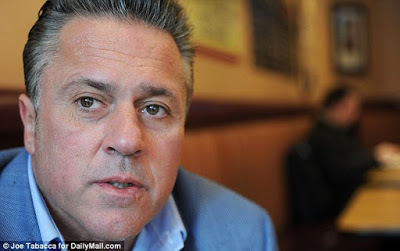 John Alite has been talking terrorism laterly
John Alite has been talking terrorism laterlyJohn Alite
 , former Gambino crime family associate, offers part two of his discussion centering on "the link between the Italian Mafia, ISIS and how buying drugs lines the pockets of terrorists."
, former Gambino crime family associate, offers part two of his discussion centering on "the link between the Italian Mafia, ISIS and how buying drugs lines the pockets of terrorists.""They both work off the same methods, which is fear and laundering money from drug sales," Alite said.
He notes that terrorists he met while in prison seemed to be "misfits, insecure and vulnerable when brought into" organized terrorism groups.
DISCLOSURE: I write for The Insider Magazine.

"Their mentality is warped," he said of the terrorists. To hear the rest, watch his video on The Insider Magazine. (Video embed was unavailable.)
To see part one, see below video.
In other John Alite news, here's an article from the Huffington post by Peter Lance, the journalist who wrote the forward to Shadow of My Father (by John A. "Junior" Gotti), see below, right.
 The title of Lance's story kind of says it all -- but Alite is still around so I don't think this investigation amounted to much: Letter to Judge prompts investigation by the U.S. Probation Office into allegations that former Gambino associate John Alite violated the terms of his Supervised Release.
The title of Lance's story kind of says it all -- but Alite is still around so I don't think this investigation amounted to much: Letter to Judge prompts investigation by the U.S. Probation Office into allegations that former Gambino associate John Alite violated the terms of his Supervised Release.Who is John Alite?
I know some of you may be wondering this -- and may even be embarrassed to ask now.
Well, no need to be embarrassed here.... Alite testified in the last of John A. Gotti's trials.
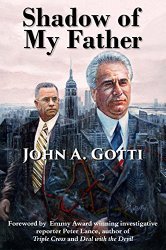 From a prison in Brazil, he debuted in a New York courtroom as the star witness.
From a prison in Brazil, he debuted in a New York courtroom as the star witness. Yet Gotti still won the trial -- the judge declared a mistrial once he realized that the jurors were solidly deadlocked on the verdicts.
It's amazing that the courtroom didn't catch fire, so intense was the New York/global media's spotlight on this trial, as well as on each of the Gotti trials.

One especially tense moment occurred, however, when Gotti grew furious at Alite and had what some newspapers desribed as an outburst that led to both men having words.
It must have been quite a scene to have witnessed live. Sure wish I had....
The trial in U.S. District Court in Manhattan broke for lunch. The jury had departed the room. Alite walked out of the courtroom. And boom! The two nearly started throwing punches right then and there...
Judge Kevin P. Castel warned both men that they would be in contempt of court if there was another nasty encounter.




Published on December 19, 2015 13:43
John Alite Talks Terrorism, Cosa Nostra with Insider Magazine
 John also mentions a new book in the works about his life on the run.
John also mentions a new book in the works about his life on the run.John Alite
 , former Gambino crime family associate, offers part two of his discussion centering on "the link between the Italian Mafia, ISIS and how buying drugs lines the pockets of terrorists."
, former Gambino crime family associate, offers part two of his discussion centering on "the link between the Italian Mafia, ISIS and how buying drugs lines the pockets of terrorists.""They both work off the same methods, which is fear and laundering money from drug sales," Alite said.
He notes that terrorists he had met while in prison seemed to be "misfits, insecure and vulnerable when brought into" organized terrorism groups.

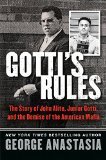 "Their mentality is warped," he said of the terrorists.
"Their mentality is warped," he said of the terrorists.To hear the rest, watch his video on The Insider Magazine. (Video embed was unavailable.)




Published on December 19, 2015 13:43
December 18, 2015
Clemenza "Never" Would've Testified, Actor Said
 Richard Castellano - the last name ring a bell?
Richard Castellano - the last name ring a bell?One of the best things about The Godfather
 was Richard Castellano
was Richard Castellano , aka Peter Clemenza, a caporegime under in one of the greatest motion pictures ever released by a studio.
, aka Peter Clemenza, a caporegime under in one of the greatest motion pictures ever released by a studio.The film also probably served as one of the mob's greatest recruitment tools ever. And if you're wondering, I did ask a couple of wiseguys what they thought about The Godfather. One of them, who must remain anonymous, told me two things: Don Vito was based on a composite of all five titular family bosses. Also a made guy was murdered as a direct result of the film's release, a story I'll save for another time (it had something to do with the Virgil "The Turk" Sollozzo" actor).
Former Gambino capo Micheal "Mikie Scars" DiLeonardo was succinct. "Epic," he described the first two Godfather films. As for the widely despised third offering: "I walked out of the theater when the helicopters started shooting everyone. I had had enough at that point, became a Bruce Willis fan."
Like many of you I am sure, I thought it was downright criminal that Castellano didn't reprise his great role for the sequel. Castellano brilliantly played the portly Clemenza. He is known to have improvised one of the film's several famous lines....
To the scripted line “Leave the gun,’’ Castellano memorably added, “Take the cannoli.’’
The story that supposedly explained the actor's absence from the film I found to be oddly unsatisfying -- not quite believable even. Francis Ford Coppola -- whose unending battles with producers and many Paramount executives has been told and retold sparing few details -- apparently wasn't above acting out his own version of the ruthless mob boss when it suited him, according to an interview Castellano, who died in December of 1988, once gave.
And, yes, Castellano is related to Paul Castellano, at least according to Richard's widow, Ardell Sheridan, who disclosed this in her book Divine Intervention and a Dash of Magic unraveling The Mystery of "The Method" (Behind the scenes of Godfather 1), published in 2002. ( And yes, I am still working on my Paul Castellano story. In addition, I am pleased to add, my story will include new information courtesy of a Gotti family member. .)
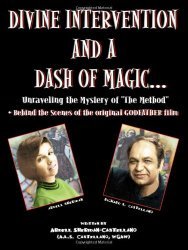 Castellano's widow's 2002 book.
Castellano's widow's 2002 book.
The great auteur Coppola famously said he had no choice but to drop Castellano from Godfather II
 . Quite clearly -- and with the requisite trace of residual befuddlement -- Coppola proclaimed on the GF2 audio commentary that
Castellano's sublime character was killed off because he'd asked for too much money and also because he wanted written into the contract that he could hire his own writer to craft his character's dialogue in the film.
. Quite clearly -- and with the requisite trace of residual befuddlement -- Coppola proclaimed on the GF2 audio commentary that
Castellano's sublime character was killed off because he'd asked for too much money and also because he wanted written into the contract that he could hire his own writer to craft his character's dialogue in the film.That simply doesn't sound like the rotund goodfella Clemenza (alas, it seems that fans including myself have (subliminally?) bestowed Clemenza's personality onto the man who played him. Castellano did nothing to allay this viewpoint when he spoke of his nuanced character, a likeable mob capo who was not one to disobey an order to kill a formerly trusted soldier when an acting boss gave him the nod). As The Godfather Wikia (yes, there is such a site, which distills bios, etc. for characters using both Mario Puzo's book as well as the films as source material) describes Clemenza:
Friendly and jovial, Clemenza was known as a storyteller among many of his acquaintances and family members - a trait that endeared him to Vito, who loved listening to storytellers. Peter Clemenza got his start selling stolen goods such as dresses and guns with Vito and Tessio as far back as 1917, and became a key figure in the growing Corleone family. Vito kept him close through the years - even making him godfather to his oldest son Santino - though this was all to control his brutal and more ambitious tendencies.
I will admit now that I never made it all the way through The Godfather
 book. There, I said it. But even Coppola was not fond of the entire novel. He in fact created the classic film by lifting the book's plotline involving the Corlenone family, meaning father, Vito, and his three sons, and of course, Connie. The rest of the novel -- including the woman with the too-large vagina, for example -- was left on on the cutting room floor inside Coppola's brain.
book. There, I said it. But even Coppola was not fond of the entire novel. He in fact created the classic film by lifting the book's plotline involving the Corlenone family, meaning father, Vito, and his three sons, and of course, Connie. The rest of the novel -- including the woman with the too-large vagina, for example -- was left on on the cutting room floor inside Coppola's brain.However, by not reading the bulk of the novel, one misses out on some tasty morsels, such as the deliciously demonic origin story of the Don's most loyal henchman, Luca Brasi....
Luca attempted to force [his grilfriend] to have an abortion, which she refused. On the day of his son's birth, he forced the midwife, Filomena under pain of death, to hurl his own son into a furnace, an act for which she never forgave herself, describing him as an unholy demon that night. He claimed that "I don't want any of that race to live." It was unknown whether he meant that it was because the child was half Irish, born of a prostitute, or that it was his child, and felt that he was doing the world a favor by removing his bloodline from it....
After that night, Brasi allowed himself to be arrested, after first taking an overdose of pills that left him with permanent brain damage, slowing his speech and thought patterns. He tried to kill himself in his cell with a broken bottle by slashing his throat open but he didn't die, in the end he was rescued from prison by Vito Corleone, who saw Brasi as a potential asset....
The tales of Brasi's prowess soon became legend. One such incident involved Brasi killing off Benny Amato and Joey Daniello, two of Al Capone's henchmen hired to kill Don Corleone. Brasi subdued both of them and tied and gagged them with towels stuffed in their mouths. He then leisurely hacked Amato to pieces with an axe. When he went to finish off Daniello he found that he had gone through a shock convulsion and choked to death on the towel.
Brasi's talent, it was said, was that he could do a job, or murder all by himself, without confederates or backup who might rat him out. Since Luca made sure to leave no witnesses either, this made a criminal conviction almost impossible. He is also known for killing, in two weeks, six men who attempted to kill Don Corleone at a festival....
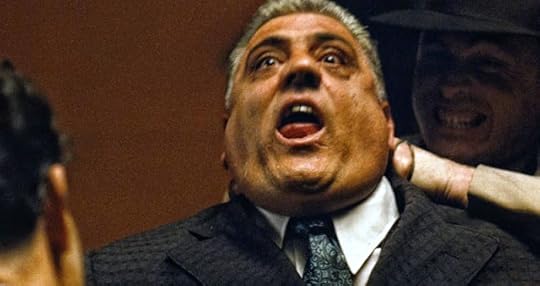 The Turk was wise indeed to take Luca Brasi out first....
The Turk was wise indeed to take Luca Brasi out first....To any storyteller -- and most cinephiles -- the very notion of simply adding a writer to draft dialogue not organically composed as part of the whole story is at the very least bizarre. (There's more to writing fiction, including screenplays -- good ones, anyway -- than meets the eye, such as subtext, thematic constructs, symbolism, balance, rhythm and poetry, etc.)
Since first hearing it on the DVD, I swallowed Coppola's commentary about the "demanding" Castellano with a shovelful of salt.
An interview with Richard Castellano I recently discovered seemed to finally explain why Frank Pentangeli, and not Clemenza, showed up at the Corleone family's Nevada compound. (Castellano's explanation has a huge flaw in it, alas, though I didn't find it until revising an initial draft of this story.)
"Frankie Five Angels" is no Clemenza but he did a damn good job...
 Frankie Five Angels was clearly based on Joe Valachi.
Frankie Five Angels was clearly based on Joe Valachi.The New York Post reported this seemingly more-realistic reason, which came from Castellano's own mouth.
Interviewed in 1981, his acting career had nearly run its course; he was answering phones for a company based inside a friend’s Guttenberg, NJ garage.
During a five- hour interview, he was especially eager to talk about his clashes with Coppola on “The Godfather’’ and its sequel — and how their conflict damaged Castellano’s career.
According to the actor, the original script for “Part II” had his character testifying before a congressional committee against the crime family headed by Michael Corleone. The scene was ultimately rewritten for another character, Frankie Pentangeli, played by Michael V. Gazzo.
“I saw Clemenza as a teacher,’’ Castellano said. “He teaches how to make spaghetti, how to use the gun. [Coppola] can’t tell me that Clemenza, after years of loyalty to the old man, would go in and testify against organized crime. Not unless you proved to me . . . that he had become a fearful man, that he had become a betrayer.
“The demands on me were impossible. I had settled on a price and everybody else’s was settled upon mine. [Coppola] had me losing weight to play Clemenza as a young man. I was down to 194 pounds. When I received the script five minutes later, it had me rolling in at 300 pounds.’’ Castellano says that after he bowed out of the project — Bruno Kirby Jr,. played the young Clemenza, who is said to have died before the “Part II’’ scenes set in the 1950s — Coppola promised to tell the press he had turned down the role for artistic reasons.
“The next thing, I saw Coppola quoted as saying that I asked for more money than anyone else, that I asked to rewrite the script. Once the lie gets out, the lie is told, and it takes.’’ (Coppola said in a DVD documentary a few years ago that Castellano was dropped because he insisted on approval of his character’s lines).
Castellano said Copolla really went for him after he'd had the gall to intercede while Coppola was engaged in a heated argument with his cinematographer, Gordon Willis. Castellano was trying to defend Willis. According to Castellano, Coppola got his revenge while shooting Clemenza's final scene. The heavyset actor had to walk up four sets of stairs repeatedly, as Coppola kept finding faults with each take.
One thing Castellano wouldn’t comment on was a rumor that he had connections to organized crime. After the actor’s death, his widow wrote in a book that he was nephew to Paul Castellano, the Gambino crime family boss who was assassinated in 1985...
The only problem with Castellano's explanation for dropping out is that Pentangeli technically committed suicide, as was common among ancient Rome's emperors, or something like that, as explained in the film. In other words, the character never really did Michael any damage. (Unless, of course, Coppola's bitter half got the best of him -- and he rewrote the script based on Castellano's input about Clemenza the teacher....
What do you think?




Published on December 18, 2015 19:23
December 14, 2015
Cop Caliber Slugs in 4 Slain in Waco Biker Brawl
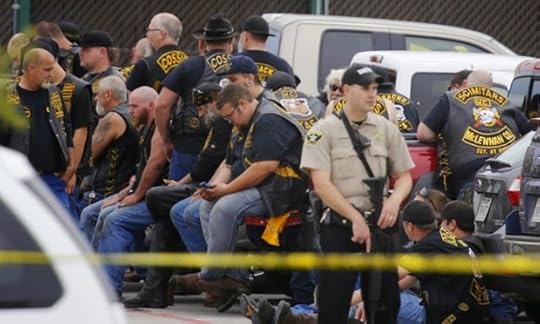 The Cossack and Scimitar MCs are affiliated with the Hells Angels, adding new dimension to the story.
The Cossack and Scimitar MCs are affiliated with the Hells Angels, adding new dimension to the story.Four of the nine people who died as rival biker gangs began brawling outside a Waco, Texas-based Twin Peaks restaurant were killed with the same caliber used by Waco police rifles.
This is according to a Waco Trib report based on evidence obtained by the AP "that provides the most insight yet into whether authorities were responsible for any of the deaths and injuries."
Two of the four dead had wounds from only that kind of rifle; the other two were shot by other kinds of guns as well. The ballistics reports show that the rest killed were shot by a variety of other guns. It was not clear whether any bikers had similar guns to the police. Twelve long guns, which could include rifles, were seized by law enforcement on that day.
Gangsters Out Blog reported on an interesting dynamic at work, however:
"The Bikers were claiming they were innocent victims of a police genocide. However, the evidence paints a different picture. The Bandidos and the Cossacks had a history of violence. The Bandidos are rivals of the Hells Angels and claim ownership of Texas. The Cossacks are a puppets club of the Hells Angels. A fight broke out, someone was stabbed. The fight went into the parking lot where guns came out and people were shot. The police opened fire. According to the New York Times, eight of the nine victims were members of the Cossacks. One was with the Bandidos. So it's still about the Hells Angels attempt to take over the drug trade.
As noted here, drug dealing in the southern border states has gotten a shot in the arm (forgive the pun) thanks to the Cartels, which are also seeking to tap the U.S. market.
The Mexican Cartels seem to be ramping up production of meth and cocaine for distribution inside the United States. This is because America's laws regarding marijuana continue to evolve.
Apparently the cartels expect weed to be widely legal here to the extent that there will be no more profit in selling that particular drug.
As the Washington Post reported:
Mexican traffickers are sending a flood of cheap heroin and methamphetamine across the U.S. border, the latest drug seizure statistics show, in a new sign that America’s marijuana decriminalization trend is upending the North American narcotics trade.
The amount of cannabis seized by U.S. federal, state and local officers along the boundary with Mexico has fallen 37 percent since 2011, a period during which American marijuana consumers have increasingly turned to the more potent, higher-grade domestic varieties cultivated under legal and quasi-legal protections in more than two dozen U.S. states.
In any event we believe the southern-based biker gangs will begin killing each other more than ever because of the increasingly profitable drug business's "new paradigm."
<




Published on December 14, 2015 12:18
4 Slain in Waco Biker Brawl by Same Caliber Cops Used
 The Cossacks, affiliated with the Hells Angels, adds new dimension to the story.
The Cossacks, affiliated with the Hells Angels, adds new dimension to the story.Four of the nine people who died as rival biker gangs began brawling outside a Waco, Texas-based Twin Peaks restaurant were killed with the same caliber used by Waco police rifles.
This is according to a Waco Trib report based on evidence obtained by the AP "that provides the most insight yet into whether authorities were responsible for any of the deaths and injuries."
Two of the four dead had wounds from only that kind of rifle; the other two were shot by other kinds of guns as well. The ballistics reports show that the rest killed were shot by a variety of other guns. It was not clear whether any bikers had similar guns to the police. Twelve long guns, which could include rifles, were seized by law enforcement on that day.
Gangsters Out Blog reported on an interesting dynamic at work, however:
"The Bikers were claiming they were innocent victims of a police genocide. However, the evidence paints a different picture. The Bandidos and the Cossacks had a history of violence. The Bandidos are rivals of the Hells Angels and claim ownership of Texas. The Cossacks are a puppets club of the Hells Angels. A fight broke out, someone was stabbed. The fight went into the parking lot where guns came out and people were shot. The police opened fire. According to the New York Times, eight of the nine victims were members of the Cossacks. One was with the Bandidos. So it's still about the Hells Angels attempt to take over the drug trade.
As noted here, drug dealing in the southern border states has gotten a shot in the arm (forgive the pun) thanks to the Cartels, which are also seeking to tap the U.S. market.
The Mexican Cartels seem to be ramping up production of meth and cocaine for distribution inside the United States. This is because America's laws regarding marijuana continue to evolve.
Apparently the cartels expect weed to be widely legal here to the extent that there will be no more profit in selling that particular drug.
As the Washington Post reported:
Mexican traffickers are sending a flood of cheap heroin and methamphetamine across the U.S. border, the latest drug seizure statistics show, in a new sign that America’s marijuana decriminalization trend is upending the North American narcotics trade.
The amount of cannabis seized by U.S. federal, state and local officers along the boundary with Mexico has fallen 37 percent since 2011, a period during which American marijuana consumers have increasingly turned to the more potent, higher-grade domestic varieties cultivated under legal and quasi-legal protections in more than two dozen U.S. states.
In any event we believe the southern-based biker gangs will begin killing each other more than ever because of the increasingly profitable drug business's "new paradigm."
<




Published on December 14, 2015 12:18



